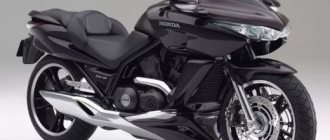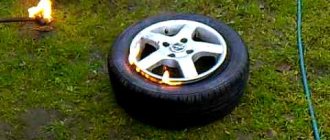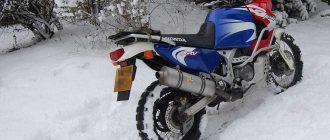Description
The Suzuki Desperado 400 cruiser model was first introduced in 1996 on the basis of the older version of the Suzuki Desperado 800. The model was aimed at the domestic Japanese market and was not officially supplied to other countries. Since 1997, the maximum engine power has been increased to 38 hp. (instead of 33 hp) and the model received several visual differences. In 1999, the Winder modification appeared, which was not in the older version (Suzuki Desperado 800) - it was distinguished by a combination of common features from the Desperado 400 and VS400 Intruder. The year 2000 was the last year of production of the model, after which it was finally discontinued and did not receive further development. Only in 2005, as a successor, the Suzuki Boulevard 400 model was introduced.
Main modifications of the Suzuki VZ400 Desperado:
Suzuki Desperado 400 is the basic regular version.
Suzuki Desperado 400X - version with front semi-fairing and lower “fang”.
Suzuki Desperado 400 Winder - has been available since 1999. It features a 19′ front spoked wheel, front brake, high handlebars, forks, rear suspension from a Suzuki VS400 Intruder and a black engine.
The Suzuki VZ400 Desperado is based on a 2-cylinder V-twin liquid-cooled engine with a volume of 399 cc. see, producing 38 hp. capacity (since 1997). This figure is the highest among similar models of this class. In addition, the Desperado 400 is the lightest in its class.
Features of the Suzuki VZ400 Desperado include a steel frame, alloy wheels, an inverted fork, a 5-speed gearbox, a chain drive and a 13-liter fuel tank.
Review of the Suzuki VZ 400 Desperado motorcycle
Well, it’s the beginning of the season, the spendthrift made me happy every day more and more. It beats quite decently, everything that was on the speedometer was put in place without any problems. It doesn’t eat oil, in traffic jams....however, what kind of traffic jams are there on a motorbike It handles perfectly, the brakes are excellent, the dynamics are quite enough for me. Driving with a two-wheeler is almost not noticeable. In general, the time has come for my first long-distance trip. Route St. Petersburg-Bryansk region-St. Petersburg. 1450 km one way.
I didn’t buy any trunks; in the end, I took everything I needed and put it in a regular briefcase (red fox, container). I monitored the weather along my route and left at night.
After 400 km of continuous driving, I realized that every bump was simply crushing my spine, the problem was solved in 15 seconds. Shock absorbers to the softest position and off you go. Here it is morning, here it is raining... well, of course, I was perfectly prepared and it saved me from the rain - nothing saved me. I drove about 150 km in the rain. After which I made a stop and set up a campsite with drying clothes, both upper and lower. Having not reached the destination about 100 km, the moto began to twitch and fart with flames Fortunately, it’s a populated area and I’m ready, as always. After all, I have a regular set. After poking around for about 15 minutes, I decided to look at the quality of the fuel, removing the hose from the fuel pump, I realized that I had gotten into it... something was leaking out of there and sand and everything that didn’t get in... after draining the fuel, I decided to check for flammability.. but it refused to burn, that’s how I I refueled in a miracle phaeton after 2-3 hours the carbs and tank were cleaned. I ran to the gas station and bought normal gasoline = I decided to play it safe and installed a fuel filter from diesel cars. The engine barely started and I rushed to my destination with occasional twitching and shooting. After about 70 km, everything returned to normal and the Winder carried me without problems.
After 2 weeks of riding along village and country roads, I saw the disadvantages of this moto. He is very short. Of course it is designed for a good road, but there were places where I just hung on it and it was sad.
The way back was without any jokes.
In the end, what can I say about Desperado Winder: For 1 mota, this is a bomb. I raced with Steeds and Shadows and other 400-600s of this class at 750 meters, and all of them are left behind already from 2nd gear. The seating position is comfortable, the steering wheel is comfortable, and the standard mirrors are informative. It is very easy and predictable to drive. In appearance...to each his own...I liked it for its individuality...after all, the winder modification was produced for only a year and is extremely rare to see on the road. In terms of reliability... I give it a solid 5. Although I fumbled with it on the way, it was my mistake.... in the following days I drove and did not know grief, the suspension is good (it never gave way), although I also carried fat taverns.
In short, it's a cool mot!!!! I am very pleased that I purchased it.
I bought it in 2011 with 11,000 km on it (apparently it was twisted). This is my first motorcycle, so I chose it more by appearance than by technical characteristics. I have never regretted taking it. Externally it looks like its 800cc counterparts. The cooling system costs from 800k, it is impossible to overheat. Excellent steering, acceleration is probably the most vigorous among its classmates, braking is also excellent. It easily maintains a cruising speed of 100 km/h. Ridiculous consumption: the tank does not last 300 km, although it is not large. The narrow steering wheel gives excellent maneuverability in traffic jams. All these are huge advantages for a beginner. With a standard set of tools you can disassemble and reassemble almost the entire motorcycle. Even an amateur with weak hands can change spark plugs, oil, filters, and pads. Of the minuses: the seat is not very comfortable, this can be solved by installing a tuning device. Due to the narrow steering wheel, visibility in the mirrors is not very good. The suspension is too soft; breakdowns occur when driving with a passenger. But if you travel alone, you won’t notice any disadvantages. Bottom line: an excellent mot for the money, it has never let me down. I traveled both around the city and to the region, but without hellish long distances. I spent the winter in a cold garage and started without any problems. For 1.5 seasons there was not a single breakdown, I only changed consumables. Good luck to everyone on the roads!
Hello. I got hooked on motorcycles back in 2008). I found an ad for a 1995 CBR900RR (which was enough for $). The owner took me for a ride around the city in number 2 and I was impressed. We left the city, stopped and said, “Do you want it yourself?” (which surprised me, because even at the beginning of the conversation I said that I had never driven an imported one, much less a sports one). Of course I agreed. A short course for an idiot (highside, wheelie, stoppie) and I’m in the saddle... You can write a lot about the emotions of driving a fire, and even with my driving experience)).... In general, the owner asks: “So how?” , I smile stupidly. He asks: “Are you afraid of him?”, I agree. Then he says, don’t take it. And I didn’t take it... About a week later, at a used salon, a mechanic, after listening to me about that fire, offered to sit down on the Desperado 400X... The steering wheel fell into my hands, the same with my legs—in general, I liked it. I won’t write about appearance; it’s a matter of taste. I was not allowed to pass (no category A). In general, I left the salon in doubt). On the one hand, on the other hand..... In short, I threw a coin and it came up YES. I bought it and have never regretted it! Over 4 seasons I replaced: ignition switch, 1 fuse, fork seals, brake pads, headlight bulb). Initially I took the bike for recreation, but later I switched to it completely. Despite its decent size and weight (for a 400), it is very narrow, there is no discomfort in traffic jams, handling, brakes - everything is decent. For example, motorcycle eight is easy to pass in the traffic police. The lack of power is felt when accelerating after 120 km/h. Overall dynamics (for a 400k chopper) in city traffic is 5+. I would also like to note the democratic nature of SUZUKI’s design for choosing equipment or lack thereof. I would also like to say a special thank you to the Desperado engineers for the water cooling and propeller. At temperatures above +30 in the shade, in traffic jams, as well as on poor-quality country dirt roads, when you have to move slowly and far, and you don’t have any problems with overheating. In conclusion, I want to say: “I am grateful to this motorcycle for the sensations that I experienced...”
I drove Desperado for a couple of seasons. I liked Mot. I did all the service myself - fortunately it’s simple. Engine is gold!! It pulls like a Ural!! (for comparison, so you understand) The presence of a passenger only affected the maximum speed (20 km less) (without a passenger 148). And so he doesn’t notice him. The engine spins up to approximately 7500, but I drove from 1200-2500. Pulls great and has the right sound! Somewhere in the range from 4000 to 5000 there lives a cheerful pickup))) Consumption: my record with a passenger for 11 liters is 330 km. My Anti-Record is 100 km with the same 11 liters. It depends on how short the ride is. Gearbox: 5 gears. 1 is very short)))) That’s why I didn’t use it. 2-3-5. 4 also somehow falls out of the chopper-cruiser driving style)). Moreover, the presence of a passenger does not affect anything. so 2-3-5. The gearbox worked smoothly, sometimes there was a glitch with 1st gear - it wouldn’t engage! This was treated by releasing the clutch. And later I stopped using it altogether. Chassis: chassis like chassis. Nothing special. The front shifter is good. The rear shocks have adjustable spring preload. The peculiarity of the control is that the bike must be tilted with its body into a turn. It’s not that it’s a flaw, you just don’t realize it right away.
Brief history of the model
1996 - start of production and sales of the Suzuki Desperado 400. This generation is distinguished by an engine power of 33 hp, a rectangular air filter cover (glove box) and a “crossed” exhaust system. Model: Suzuki Desperado 400 / Desperado 400X (Japan). Factory designation: VZ400T / VZ400ZT.
1997 - the model undergoes some changes. The “crossed” exhaust system is changed to a straight one, the air filter cover (glove box) takes on a rounded shape, and the maximum engine power increases to 38 hp. Model: Suzuki Desperado 400 / Desperado 400X (Japan). Factory designation: VZ400V / VZ400ZV.
1999 - appearance of the Winder modification. Model: Suzuki Desperado 400 / Desperado 400X / Winder (Japan). Factory designation: VZ400V / VZ400ZV / VZ400BX.
2000 is the last year of production.
Specifications
| Model | Suzuki VZ400 Desperado |
| Motorcycle type | cruiser |
| Year of issue | 1996-2000 |
| Frame | steel tubular |
| engine's type | 2-cylinder, 4-stroke, V-shaped |
| Working volume | 399 cc cm. |
| Bore/Stroke | 65.0 x 60.2 mm |
| Compression ratio | 10,5:1 |
| Cooling | liquid |
| Number of valves per cylinder | SOHC, 4 valves per cylinder |
| Fuel supply system | carburetor, 2x Mikuni BDS32 / BS32 |
| Ignition type | fully transistorized |
| Maximum power | 33 hp (24.3 kW) at 7500 rpm – VZ400T / VZ400ZT 38 hp (28 kW) at 8500 rpm – VZ400V / VZ400ZV / VZ400BX |
| Maximum torque | 32 Nm (3.3 kgf*m) at 6000 rpm – VZ400T / VZ400ZT 33 Nm (3.4 kgf*m) at 6000 rpm – VZ400V / VZ400ZV / VZ400BX |
| Transmission | 5-speed |
| type of drive | chain |
| Front tire size | 130/90-16M/C 67H — VZ400T/VZ400ZT, VZ400V/VZ400ZV 100/90-19 57H — VZ400BX |
| Rear tire size | 150/90-15M/C 74H |
| Front brakes | 1 disc, 310 mm, 2-piston caliper - VZ400T/VZ400ZT, VZ400V/VZ400ZV 1 disc, 300 mm, 2-piston caliper - VZ400BX |
| Rear brakes | drum |
| Front suspension | inverted fork, travel - 140 mm - VZ400T/VZ400ZT, VZ400V/VZ400ZV telescopic fork, travel - 130 mm - VZ400BX |
| Rear suspension | pendulum with two shock absorbers (preload adjustment), stroke - 102 mm - VZ400T/VZ400ZT, VZ400V/VZ400ZV pendulum with two shock absorbers (preload adjustment), stroke - 90 mm - VZ400BX |
| Gas tank capacity | 13.0 l, including reserve - 3.0 l |
| Length | 2360 mm - VZ400T, VZ400ZT 2370 mm - VZ400V, VZ400ZV 2390 mm - VZ400BX |
| Width | 750 mm - VZ400T/VZ400ZT, VZ400V/VZ400ZV 870 mm - VZ400BX |
| Height | 1115 mm - VZ400T, VZ400V 1140 mm - VZ400ZT, VZ400ZV 1170 mm - VZ400BX |
| Wheelbase | 1650 mm |
| Seat height | 700 mm - VZ400T, VZ400ZT 685 mm - VZ400V, VZ400ZV, VZ400BX |
| Maximum speed | 150 km/h |
| Acceleration to 100 km/h (0-100) | 9.5 sec |
| Motorcycle weight (dry) | 199 kg - VZ400T, VZ400V 201 kg – VZ400ZT, VZ400ZV 195 kg - VZ400BX |
Suzuki Desperado - 400, you can turn your head
Alexey SEREBRENNIKOV, photo by Dmitry IVAIKIN
(Page 2)
[1] [2]
Admire: this is what a 1645 mm base is.
The engine is balanced so well that at idle speed its sound is barely audible, and only when the speed increases does it sound somehow excited and in a special guttural bass.
And here’s another strange thing I encountered. In appearance, the motorcycle seems to declare its great power and considerable potential, but inside the Desperado 400 is different: you have to take off with good throttle. This is understandable: 33 horsepower in the engine is clearly not enough for a mass of almost two hundredweight. However, depending on what for. Even with its rather modest “power supply” indicator - 1 liter. With. by 6 kg of weight - this is more than enough to “run away” from a traffic light from almost any mass-produced car. But I won’t say that accelerating to maximum speed is easy: the 140 km/h mark is not easy for a motorcycle. The maximum is reached in fourth, not fifth gear (the highest is most likely intended to save fuel). Driving over 120 km/h will not be fun. The most comfortable driving mode on the Desperado 400 is in the range of 90-120 km/h. At these speeds, the engine’s singing is pleasant, and the engine’s reactions to your actions are adequate; the aerodynamic properties of the motorcycle will allow you to escape from the actual control process - so that, if you want, you can lose yourself in the journey. The huge wheelbase is 1650 mm (larger than any of its competitors, such as the Kawasaki Vulcan Classic - 1605 mm, Yamaha Drag Star 400 - 1610 mm) - and this gives the Desperado excellent straight-line stability.
The instrument cluster is designed very simply.
And the motorcycle turns completely reluctantly: if it fits quite well at small angles, then it resists deep inclinations. That’s why I wouldn’t recommend taking turns actively—it’s scary, you know. At least, after several trial attempts, the desire to actively move it from side to side completely disappeared - until the end of the test. Controlling the motorcycle in turns is hampered by its soft suspension (especially the front one), the large mass of the entire bike, as well as the front wheel, which bears significant unsprung masses, and the fact that the inverted fork installed here has a large offset.
It is with the unsprung masses that you have to “fight” more and more often than with the entire total weight of the motorcycle. I even got the impression that the front end “lives” its own separate life and, damn it, only interferes with the enjoyment of driving.
The rear brake mechanism is of the drum type, it is tenacious and adequate, always accurately responds to any of your actions, and the wheel locks up exactly when you expect it. The front brake (it is single-disc, 4-piston) presented a surprise: the wheel locks up too early, with not very significant force on the lever. And this is all the more surprising since the braking tests took place in 32-degree heat, under the scorching sun. One can only guess how the motorcycle will behave in a similar situation in colder weather or, for example, in rain. Be sure to keep this in mind.
I’ll tell you what I remember about this test: I didn’t strain myself, I didn’t work hard, but I relaxed and rested, I was uninhibited and had time to admire something else around me, except for the tachometer (now I will often look at it while flying home on my FZR600) . I want a Desperado 400 with a balanced owner who will fill the machine with expensive oil and be sure to properly polish the chrome sides. We thank the NBS-Motor motorcycle dealership for providing us with a motorcycle for testing.
For drivers below 165 cm, the panel is seen without the “neutral” and “turn signal” indicators.









